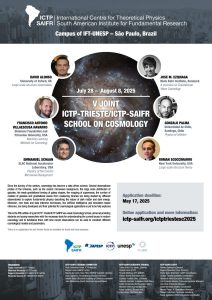V Joint ICTP-Trieste/ICTP-SAIFR School on Cosmology

July 28 – August 8, 2025
ICTP-SAIFR, São Paulo, Brazil
ICTP-SAIFR/IFT-UNESP
Home
Since the turn of the century, cosmology has become a data driven science. Several observational probes of the Universe, such as the cosmic microwave background, the large scale distribution of galaxies, the weak gravitational lensing of galaxy shapes, the mapping of supernovas, the number of clusters of galaxies and gravitational waves from coalescing binaries are being studied by different observatories to explore fundamental physics describing the nature of dark matter and dark energy. Moreover, new tools and data intensive techniques, like artificial intelligence and simulation based inference, are being developed and their potential for cosmological applications is yet to be fully explored.
This is the fifth edition of a joint ICTP-Trieste/ICTP-SAIFR two-week Cosmology School, aimed at providing students and young researchers with the necessary tools for understanding the current issues in modern cosmology and to familiarize them with how recent observations can be used to constrain different cosmological models and parameters.
Previous events:
IV Joint ICTP-Trieste/ICTP-SAIFR School on Cosmology: Challenges for the Standard Cosmological Model
III Joint ICTP-Trieste/ICTP-SAIFR School on Observational Cosmology
II Joint ICTP-Trieste/ICTP-SAIFR School on Open Problems in Cosmology
- Paolo Creminelli (ICTP-Trieste)
- Mehrdad Mirbabayi (ICTP-Trieste)
- Rogerio Rosenfeld (IFT-UNESP/ICTP-SAIFR)
- Riccardo Sturani (IFT-UNESP/ICTP-SAIFR)
There is no registration fee and limited funds are available for travel and local expenses.
List of participants here.
Announcement:
Application deadline: May 17, 2025 (closed)
Lecturers
Lecturers
1st week
- Roman Scoccimarro (New York University, USA): Large scale structure theory
- Gonzalo Palma (Universidad de Chile, Santiago, Chile): Physics of Inflation
- Jose M. Ezquiaga (Niels Bohr Institute, Denmark): A premiere on Gravitational Wave Cosmology
2nd week
- Emmanuel Schaan (SLAC National Accelerator Laboratory, USA): Physics of the Cosmic Microwave Background
- David Alonso (University of Oxford, UK): Large scale structure observables
- Francisco Antonio Villaescusa Navarro (Simons Foundation and Princeton University, USA): Machine Learning Methods for Cosmology
Posters
TBA
Registration
Program
The schedule might be changed.
Reading Material
Jose M. Ezquiaga (Niels Bohr Institute, Denmark):
- Chapter 6 of the NBI lecture notes.
Roman Scoccimarro (New York University, USA):
- https://cosmo.nyu.edu/roman/courses/cosmology_2023/
- Baumann, Cosmology, 2022, Cambridge Univ. Press
- Dodelson & Schmidt, Modern Cosmology, 2021, Academic Press
- Mo, van den Bosch & White, Galaxy Formation and Evolution, 2010, Cambridge Univ. Press
Additional Information
Attention! Some participants in ICTP-SAIFR activities have received email from fake travel agencies asking for credit card information. All communication with participants will be made by ICTP-SAIFR staff using an e-mail “@ictp-saifr.org”. We will not send any mailings about accommodation that require a credit card number or any sort of deposit. Also, if you are staying at Hotel Intercity the Universe Paulista, please confirm with the Uber/Taxi driver that the hotel is located at Rua Pamplona 83 in Bela Vista (and not in Jardim Etelvina).
BOARDING PASS: All participants, whose travel has been provided or will be reimbursed by ICTP-SAIFR, should bring the boarding pass upon registration. The return boarding pass (PDF, if online check-in, scan or picture, if physical) should be sent to secretary@ictp-saifr.org by e-mail.
Visa information: Nationals from several countries in Latin America and Europe are exempt from tourist visa. Nationals from Australia, Canada and USA are required to obtain a tourist e-visa. Please check here which nationals need a tourist visa to enter Brazil.
Accommodation: Participants whose accommodations are provided by ICTP-SAIFR will stay at Hotel Intercity the Universe Paulista. Other hotel recommendations are available here.
Poster presentation: Participants who are presenting a poster MUST BRING A PRINTED BANNER . The banner size should be at most 1 m (width) x 1,5 m (length). We do not accept A4 or A3 paper.
